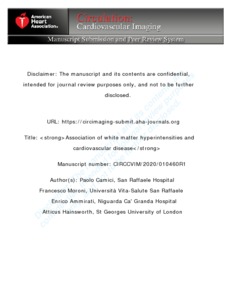Moroni, F; Ammirati, E; Hainsworth, AH; Camici, PG
(2020)
Association of white matter hyperintensities and cardiovascular disease.
Circulation-Cardiovascular Imaging, 13 (8).
e010460.
ISSN 1941-9651
https://doi.org/10.1161/CIRCIMAGING.120.010460
SGUL Authors: Hainsworth, Atticus Henry
![[img]](https://openaccess.sgul.ac.uk/112116/3.hassmallThumbnailVersion/CIRCCVIM_2020_010460%20_merged_1586107375.pdf)  Preview |
|
PDF
Accepted Version
Available under License ["licenses_description_publisher" not defined].
Download (2MB)
| Preview
|
Abstract
Cardiac and cerebrovascular diseases are currently the leading causes of mortality and disability worldwide. Both the heart and brain display similar vascular anatomy, with large conduit arteries running on the surface of the organ providing tissue perfusion through an intricate network of penetrating small vessels. Both organs rely on fine tuning of local blood flow to match metabolic demand. Blood flow regulation requires adequate functioning of the microcirculation in both organs, with loss of microvascular function, termed small vessel disease (SVD) underlying different potential clinical manifestations. SVD in the heart, known as coronary microvascular dysfunction, can cause chronic or acute myocardial ischemia and may lead to development of heart failure. In the brain, cerebral SVD can cause an acute stroke syndrome known as lacunar stroke or more subtle pathological alterations of the brain parenchyma, which may eventually lead to neurological deficits or cognitive decline in the long term. Coronary microcirculation cannot be visualized in vivo in humans, and functional information can be deduced by measuring the coronary flow reserve. The diagnosis of cerebral SVD is largely based on brain magnetic resonance imaging, with white matter hyperintensities, microbleeds, and brain atrophy reflecting key structural changes. There is evidence that such structural changes reflect underlying cerebral SVD. Here, we review interactions between SVD and cardiovascular risk factors, and we discuss the evidence linking cerebral SVD with large vessel atheroma, atrial fibrillation, heart failure, and heart valve disease.
Statistics
Item downloaded times since 13 Aug 2020.
Actions (login required)
 |
Edit Item |


